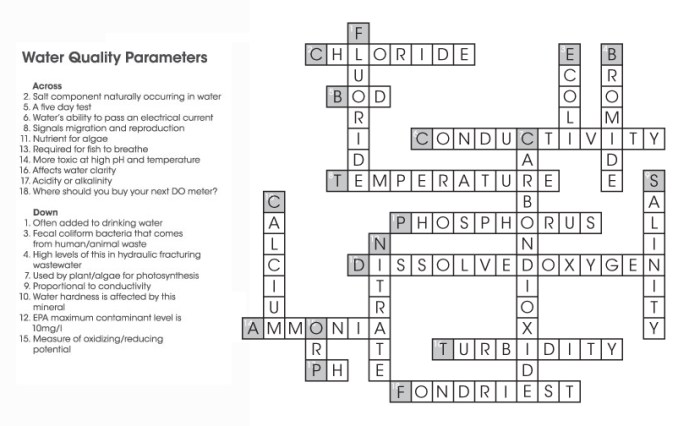Embark on an intellectual expedition with our environmental science crossword puzzle clues, meticulously crafted to challenge your knowledge and ignite your curiosity about the intricate tapestry of our planet. Dive into a world of scientific terms, ecological processes, pressing environmental issues, sustainable solutions, and career paths that shape the future of our relationship with the environment.
From the fundamental building blocks of environmental science to the complex challenges and innovative solutions that define our era, this crossword puzzle journey will illuminate your understanding of the delicate balance between humanity and the natural world.
Environmental Science

Environmental science is the study of the environment, and the interaction between humans and the natural world. It is a multidisciplinary field that draws on a wide range of scientific disciplines, including biology, chemistry, physics, and geology. Environmental science is concerned with understanding the natural world, and how human activities can impact it.
It also seeks to develop solutions to environmental problems, and to promote sustainable practices.
Environmental Science Terminology
Key Environmental Science Terms and Definitions
| Term | Definition | Example | Illustration |
|---|---|---|---|
| Biosphere | The part of the Earth where life exists | Forests, oceans, and deserts | [Ilustrasi biosfer] |
| Ecosystem | A community of living organisms and their physical environment | A forest, a coral reef, or a desert | [Ilustrasi ekosistem] |
| Biodiversity | The variety of life on Earth | The number of different species, genes, and ecosystems | [Ilustrasi keanekaragaman hayati] |
| Sustainability | The ability to meet the needs of the present without compromising the ability of future generations to meet their own needs | Using renewable resources, reducing pollution, and protecting biodiversity | [Ilustrasi praktik berkelanjutan] |
Environmental Processes

The Water Cycle
Evaporation
Water evaporates from the surface of the Earth into the atmosphere.
Condensation
Water vapor in the atmosphere condenses to form clouds.
Precipitation
Water falls from the clouds to the Earth’s surface as rain, snow, sleet, or hail.
Infiltration
Water seeps into the ground and becomes groundwater.
Runoff
Water flows over the surface of the Earth and into rivers and streams.
Significance
The water cycle is essential for life on Earth. It provides water for drinking, irrigation, and transportation. It also helps to regulate the Earth’s climate.
The Carbon Cycle
Photosynthesis
Plants use sunlight to convert carbon dioxide and water into glucose and oxygen.
Respiration
Organisms release carbon dioxide into the atmosphere when they breathe.
Decomposition
Bacteria and fungi break down dead organisms and release carbon dioxide into the atmosphere.
Fossil fuel combustion
Burning fossil fuels releases carbon dioxide into the atmosphere.
Significance
The carbon cycle helps to regulate the Earth’s climate. Carbon dioxide is a greenhouse gas, which means it traps heat in the atmosphere.
The Nitrogen Cycle
Nitrogen fixation
Bacteria convert nitrogen gas in the atmosphere into ammonia.
Nitrification
Bacteria convert ammonia into nitrite and nitrate.
Assimilation
Plants absorb nitrate from the soil and use it to make proteins.
Denitrification
Bacteria convert nitrate back into nitrogen gas.
Significance
The nitrogen cycle is essential for life on Earth. Nitrogen is a key component of proteins, which are essential for all living organisms.
Environmental Issues
Major Environmental Issues and Their Causes
| Issue | Causes | Impacts | Solutions |
|---|---|---|---|
| Climate change | Burning fossil fuels, deforestation | Rising sea levels, more extreme weather events | Reduce greenhouse gas emissions, plant trees |
| Air pollution | Burning fossil fuels, industrial activities | Respiratory problems, heart disease | Reduce fossil fuel use, invest in renewable energy |
| Water pollution | Industrial waste, agricultural runoff | Contaminated drinking water, fish kills | Treat wastewater, reduce agricultural runoff |
| Deforestation | Logging, agriculture, development | Loss of habitat, climate change | Protect forests, promote sustainable forestry |
Environmental Solutions
Sustainable Practices and Technologies
Renewable energy
Solar, wind, and geothermal energy are all renewable sources of energy that do not produce greenhouse gases.
Energy efficiency
Using energy more efficiently can help to reduce greenhouse gas emissions.
Green building
Green buildings are designed to be energy-efficient and environmentally friendly.
Sustainable agriculture
Sustainable agriculture practices can help to protect the environment and reduce pollution.
Waste reduction
Reducing waste can help to conserve resources and reduce pollution.
Environmental Careers: Environmental Science Crossword Puzzle Clue
Career Paths in Environmental Science
| Career | Description | Education Requirements | Job Outlook |
|---|---|---|---|
| Environmental scientist | Study the environment and develop solutions to environmental problems | Bachelor’s degree in environmental science or a related field | Excellent |
| Environmental engineer | Design and implement solutions to environmental problems | Bachelor’s degree in environmental engineering or a related field | Excellent |
| Environmental lawyer | Specialize in environmental law and represent clients in environmental cases | Juris Doctor (J.D.) degree | Good |
| Environmental educator | Teach people about the environment and environmental issues | Bachelor’s degree in environmental science or a related field | Fair |
Environmental Organizations
Notable Environmental Organizations and Their Missions, Environmental science crossword puzzle clue
| Organization | Mission | Contact Information |
|---|---|---|
| Environmental Protection Agency (EPA) | To protect human health and the environment | [Contact information] |
| World Wildlife Fund (WWF) | To conserve the world’s wildlife and natural habitats | [Contact information] |
| Sierra Club | To protect the environment and promote sustainable practices | [Contact information] |
Environmental Laws and Regulations
Key Environmental Laws and Regulations
| Law/Regulation | Year Enacted | Purpose | Enforcement |
|---|---|---|---|
| Clean Air Act | 1970 | To regulate air pollution | EPA |
| Clean Water Act | 1972 | To regulate water pollution | EPA |
| Endangered Species Act | 1973 | To protect endangered and threatened species | US Fish and Wildlife Service |
| Resource Conservation and Recovery Act (RCRA) | 1976 | To regulate hazardous waste | EPA |
Clarifying Questions
What is the purpose of an environmental science crossword puzzle?
To enhance knowledge, stimulate critical thinking, and foster a deeper understanding of environmental science concepts.
How can crossword puzzles help in environmental education?
By making learning interactive, engaging, and accessible, crossword puzzles reinforce environmental terminology and promote a holistic understanding of ecological processes.
What are some common environmental science terms that may appear in a crossword puzzle?
Biosphere, ecosystem, biodiversity, carbon footprint, renewable energy, and sustainable development.